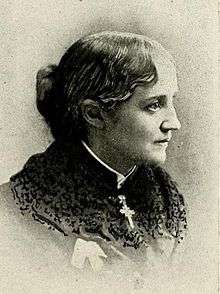Mary Wood-Allen
Mary Augusta Wood-Allen (October 19, 1841 – January 21, 1908) was an American doctor, social reformer, lecturer, and writer of books on health and self-improvement for women and children. Through her lectures and writings she was a voice for the social purity movement.[1]

Biography
Mary Augusta Wood was born in Delta, Ohio, the daughter of George Wood and Sarah (Seely) Wood.[2] She attended Ohio Wesleyan Female College, graduating in 1862.[3]
After teaching for a time at the Battleground Collegiate Institute in Battle Ground, Indiana, she married Chillon Brown Allen, a lawyer, and took the surname Wood-Allen.[3]
After three years studying in Vienna, Austria,[4] Wood-Allen earned a medical degree from the University of Michigan at Ann Arbor in 1875.[2] She went into practice in Newark, New Jersey.[3] In 1883 she was appointed "Lecturer of Heredity and Hygiene" for the National Women's Christian Temperance Union at the suggestion of Frances Willard and lectured widely on these subjects.[2][3] In 1892 she became superintendent of the WCTU's Purity Department, and in 1897 she became Superintendent of Purity for the World WCTU.[3][4]
In 1895, Wood-Allen started a series of monthly leaflets titled Mother's Friend, which was co-edited by Estelle M. H. Merrill.[5] This was expanded into the monthly magazine The American Mother (later American Motherhood), which continued publication until 1919. Wood-Allen published the magazine herself with the assistance of her son and daughter. She also published a number of books.[6] Her poem "Motherhood" was well known in its day.[7]
Family
Wood-Allen and Chillon Brown Allen married on April 15, 1863, and had separated by 1880. Wood-Allen's children were Mario Chillon Wood-Allen (1870–1936) and Rose Wood-Allen Chapman (1875–1923). Rose wrote articles and books of advice on child-rearing and in 1907 took her mother's place as the National Superintendent of Purity for the WCTU.[6]
Wood-Allen died in Washington, D.C., in 1908.
Publications
- Teaching Truth (1892)
- The Man Wonderful: The Marvels of Our Bodily Dwelling (1895)
- What a Young Woman Ought to Know (1899)
- Marriage: Its Duties and Privileges (1901)
- Child-Confidence Rewarded (1903)
- What a Young Girl Ought to Know (1905)
- Almost a Man (1907)
- Almost a Woman (1907)
- Making the Best of Our Children (2 vols, 1909)
References
- Morantz-Sanchez, Regina Markell. Sympathy & Science: Women Physicians in American Medicine. Chapel Hill, NC: University of North Carolina Press, 2000, p. 218.
- Willard, Frances, and Mary Livermore, eds. A Woman of the Century. New York: Moulton, 1893, pp. 20–21.
- Willard, Frances, and Mary Livermore, eds. American Women: Fifteen Hundred Biographies. New York: Mast, Crowell, & Kirkpatrick, revised 1897, pp. 20–21.
- Frye, Maude J. "In Memoriam". The Woman's Medical Journal 18:4 (April 1908), p. 89.
- Howe & Graves 1904, p. 376.
- The Character Builder, November 1902, pp. 211–12.
- Herringshaw, Thomas William. Herringshaw's Encyclopedia of American Biography of the Nineteenth Century, p. 36
Attribution

External links
| Wikisource has original text related to this article: |